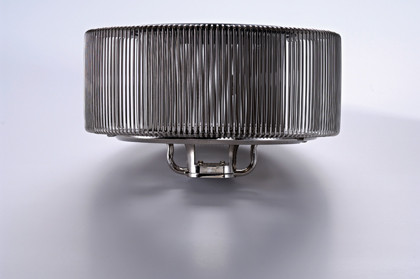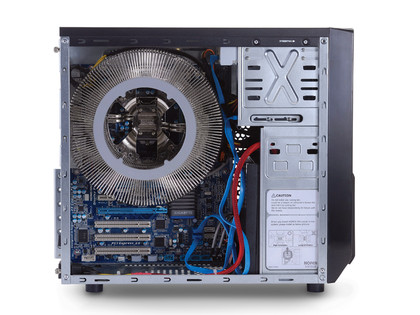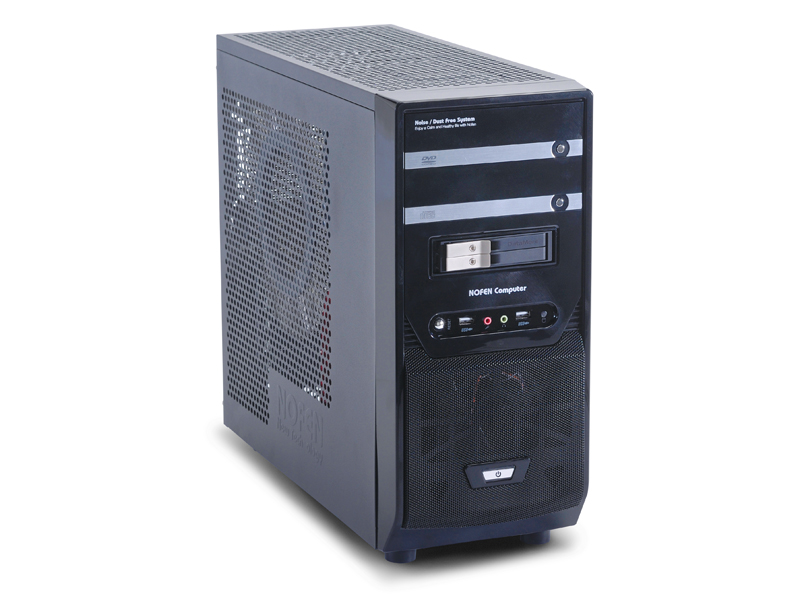TechRadar Verdict
Pros
- +
Peace and quiet
- +
Impressive temps
- +
Dust-free
Cons
- -
Discrete GPUs not welcome
Why you can trust TechRadar
Desktop PCs are noisy, obnoxious critters. They're filled with fans, you see, cooling everything from PSU to CPU to GPU. Not only do they make a ruckus, they collect dust too. That dust can slow down and damage systems over long periods of time.
So to get round these problems, NoFan has created a fanless system. The SET A40 is a really interesting bundle for your eyes, ears, and tech geek glands.
Just look at that CPU cooler for starters. What's going on there? Well, it's a passive cooler. Most current generation air coolers contain a passive cooler with a fan attached to disperse the heat.
In case you've never destroyed your CPU cooler to look inside, the heat pipe strapped to your CPU works by cycling a thermally conductive liquid/vapour to disperse thermal energy. Liquid absorbs heat at the source, evaporates, and the wick guides it away to a cooler area, where it liquefies once more, dispersing the heat from the source.
With most air coolers, there's a fan to disperse that heat further. But the CR-100A IcePipe isn't most air coolers. NoFan is being understandably cagey about the exact nature of its innovation, but what it comes down to this – inside the CR-100A IcePipe, there's no internal wick.

Mr S C Lee, the inventor and founder of Zalman, worked with physical principles discovered some 30 years ago that no one had previously been able to implement in practice, and created a heatpipe that disperses heat much more quickly and efficiently than the traditional wick design. How he managed this – well, it hurts our tiny brains here at PCF just thinking about it.
In real-world application, the possibilities are staggering. Revolutionary, even. This tech extends to refrigerators, motor vehicles, industrial machinery and beyond. We'll see what the future holds for the IcePipe, but right now it's proving to be a pretty nifty CPU cooler.
Cool under pressure

The machine NoFan supplied us with is fitted with an Intel Core i7 2600K. It's a powerful chip with great overclocking chops that throttles at temps over 80°C. Most overclockers will want to keep load temperatures under 70°C. The CR-100A IcePipe will retain temperatures within these remits, without any moving parts – with stock speeds, not overclocked.
Secondly, the cooler and case are designed for each other. The CS-30 case wouldn't work well with a traditional fan-cooled system because there's no airflow as such. It's designed for heat to escape from every surface equally, not flow over and out of certain areas.
Equally, that crazy heat pipe wouldn't work as well inside a traditional case for the same reason. It needs heat to disperse evenly from every surface of the case. It's certainly not a simple tag-in cooling solution for your current machine.
Considering that it out-prices nearly all CPU coolers (including self-contained water coolers) it might seem irrelevant. This is the first cooler of its kind, though.
Power down
There's also the P400-A PSU to add to the equation. Naturally, power supply units get seriously hot given that they're busy powering your entire rig. NoFan's PSU, though, is passively cooled, and silent.
The compromise here is that it's only 400W, so there's not much juice for this generation's power-hungry GPUs (and forget about multi-card setups), but that fits in with the system's philosophy.
There's no point ruining that peace and quiet by sticking in a discrete GPU – for starters, the massive CPU cooler blocks off the top PCIe slot and the PSU only has one six-pin PCIe power connector. You could install a passively cooled card, though.
A CPU like the i7 2600K in our review sample would be ideal, offering lightning operating speeds and formidable on-die graphics that allow you to leave your PCI-e slots empty. The 'K' part is a little irrelevant though – this isn't an overclocker's cooler. It can be done, but you won't achieve the performance boosts that a cooler half the price would allow – but again, that's not what the NoFan cooler is about.
If you're a serious gamer or overclocker you won't want the compromises the IcePipe makes for silence. You need to commit to this technology really, and there is a clear incentive to do so – silent PC operation.

Benchmarks
Idle CPU temperature performance
Temp: Degrees Celsius: Lower is better
CR-100A IcePipe: 32
CoolIT ECO A.L.C: 33
Load CPU temperature performance
Temp: Degrees Celsius: Lower is better
CR-100A IcePipe: 74
CoolIT ECO A.L.C: 57
Silence is golden
It's unnerving – turn on a system built around this bundle and nothing happens. That sound of a Victorian smelting works powering up we've come to expect from fan-cooled PCs is eerily absent.
In a home recording situation, the advantage is obvious. There's also fantastic potential for a work machine or media centre – anything but a gaming or 3D design rig that requires the heft of a discrete GPU. Of course you'll need an SSD rather than a hard drive to avoid disk whirr.
There are downsides to this bundle that extend further than simply not being able to loop the Metro 2033 benchmark over and over, though.
The case is great at working with the cooler against the common enemy of heat, but leaves a lot to be desired in other areas. It's got a visual style only its case mother could love, and that's a shame because the cooler inside looks great.
NoFan could have worked the weird angle outside as well as in to create something really desirable from a design standpoint. Instead, it's ended up looking like a turn of the millennia Packard Bell case-cum-metalwork project.
Taking off the rear panel, you can only access half the cooler's rear mounting from the back. If you want to take off the cooler for any reason, you have to remove the whole motherboard.
This in turn highlights how cramped it is inside. You need to be really clever with cable management – Quiet PC will build this bundle into a system for you if you'd like to avoid the hassle. The case is a workhorse then that does its primary job well but throws in a few niggles.
We really don't have anything bad to say about the CPU cooler and PSU though. The PSU never gets too hot to touch – or even anywhere near close. The IcePipe could be huge – for PC components and beyond.
For those who can do without a discrete GPU, it's a no-brainer. It keeps load temperatures well below the danger zone and offers 0dB operating levels, zero dust and serious power savings.
For gamers and overclockers though, the compromises it makes to keep operation silent might just prove too much.
Follow TechRadar Reviews on Twitter: http://twitter.com/techradarreview

Ad creative by day, wandering mystic of 90s gaming folklore by moonlight, freelance contributor Phil started writing about games during the late Byzantine Empire era. Since then he’s picked up bylines for The Guardian, Rolling Stone, IGN, USA Today, Eurogamer, PC Gamer, VG247, Edge, Gazetta Dello Sport, Computerbild, Rock Paper Shotgun, Official PlayStation Magazine, Official Xbox Magaine, CVG, Games Master, TrustedReviews, Green Man Gaming, and a few others but he doesn’t want to bore you with too many. Won a GMA once.
